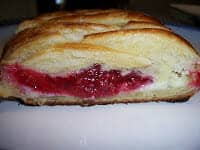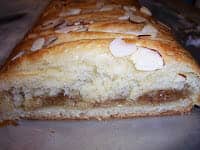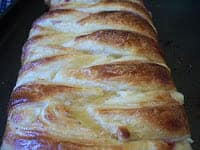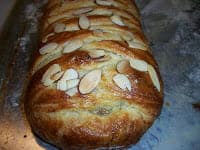

You see that photo above here? That blessed pastry almost wasn't made by me this month. I thought I probably had enough excuses to not do the Daring Baker Challenge this month. I mean, our reports for ABET Accreditation were due this month and I was the lucky one to get to edit two 400 page reports for formatting etc! I was never so happy as the day we turned those reports in for duplicating and they were out of my hands! (As I'm sure Stefan & Levon were happy to have them out of their writing hands!).
I also had the excuse that my son's wedding was coming up but honestly, that wasn't enough of an excuse since I haven't had to do a whole lot for that except get my outfit together. SO, yesterday morning I decided to start with the challenge and bake it this morning - still in time to post on the posting date!
I checked out the Daring Baker forum on a regular basis, reading what some had done with their braids, looking to see if there was any specific troubles anyone had so that if I ended up making it, I had an idea of what to do! Some people made savory braids like Bel of The Silicone Spatula, Amanda of Acker Kitchen, and Chantal of Eclectic (i-klek-tic) Desserts. They had sneak preview of their braids and they made me absolutely drool! I'm sure there were others who had savory fillings that I didn't get a chance to see ahead of time, but you can check out all the other DB'er posts by clicking here.
With all my indecisiveness about if I actually had time to do this challenge - I must say that I am VERY HAPPY I did! This was the most delicious sweet treat I have made. Although I messed up in the spreading of the butter and layering - it still turned out wonderful and now that I 've made the mistake, I know how to do it correctly the next time! I also learned that I will NOT shape the dough out onto just the counter top! That was a mistake! Fortunately, it did not affect how my braids looked in the long run.
I want to send a big thank you to Kelly of Sass & Veracity and Ben of What’s Cookin’? for hosting this month's challenge. If it were not for this challenge, I may have never tried a danish dough - and I am so glad I did. Grumpy and I are already talking about different fillings I can do for the future!
I did not use the apple filling as was suggested in the recipe. For my fillings I decided on a Raspberry/Cream Cheese and an Almond (Solo can!). Our favorite is the Almond! This one actually turned out the best looking also! Otherwise, I followed the recipe completely! I will leave you with a few more photos and then following will be the recipe. Don't let the length scare you, it really isn't hard at all!
For another take on filling for danish, be sure to check out Vohn's Vittles for Pear and Cinnamon Danish! Grumpy would love that filing I'm certain!
DANISH DOUGH
Makes 2-½ pounds dough
Ingredients
For the dough (Detrempe)
1 ounce fresh yeast or 1 tablespoon active dry yeast
½ cup whole milk
⅓ cup sugar
Zest of 1 orange, finely grated
¾ teaspoon ground cardamom
1-½ teaspoons vanilla extract
½ vanilla bean, split and scraped
2 large eggs, chilled
¼ cup fresh orange juice
3-¼ cups all-purpose flour
1 teaspoon salt
For the butter block (Beurrage)
½ pound (2 sticks) cold unsalted butter
¼ cup all-purpose flour
DOUGH
Combine yeast and milk in the bowl of a mixer fitted with the paddle attachment and mix on low speed. Slowly add sugar, orange zest, cardamom, vanilla extract, vanilla seeds, eggs, and orange juice. Mix well. Change to the dough hook and add the salt with the flour, 1 cup at a time, increasing speed to medium as the flour is incorporated. Knead the dough for about 5 minutes, or until smooth. You may need to add a little more flour if it is sticky. Transfer dough to a lightly floured baking sheet and cover with plastic wrap. Refrigerate for 30 minutes.
Without a standing mixer: Combine yeast and milk in a bowl with a hand mixer on low speed or a whisk. Add sugar, orange zest, cardamom, vanilla extract, vanilla seeds, eggs, and orange juice and mix well. Sift flour and salt on your working surface and make a fountain. Make sure that the “walls” of your fountain are thick and even. Pour the liquid in the middle of the fountain. With your fingertips, mix the liquid and the flour starting from the middle of the fountain, slowly working towards the edges. When the ingredients have been incorporated start kneading the dough with the heel of your hands until it becomes smooth and easy to work with, around 5 to 7 minutes. You might need to add more flour if the dough is sticky.
BUTTER BLOCK
1. Combine butter and flour in the bowl of a mixer fitted with a paddle attachment and beat on medium speed for 1 minute. Scrape down the sides of the bowl and the paddle and then beat for 1 minute more, or until smooth and lump free. Set aside at room temperature.
2. After the detrempe has chilled 30 minutes, turn it out onto a lightly floured surface. Roll the dough into a rectangle approximately 18 x 13 inches and ¼ inch thick. The dough may be sticky, so keep dusting it lightly with flour. Spread the butter evenly over the center and right thirds of the dough. Fold the left edge of the detrempe to the right, covering half of the butter. Fold the right third of the rectangle over the center third. The first turn has now been completed. Mark the dough by poking it with your finger to keep track of your turns, or use a sticky and keep a tally. Place the dough on a baking sheet, wrap it in plastic wrap, and refrigerate for 30 minutes.
3. Place the dough lengthwise on a floured work surface. The open ends should be to your right and left. Roll the dough into another approximately 13 x 18 inch, ¼-inch-thick rectangle. Again, fold the left third of the rectangle over the center third and the right third over the center third. No additional butter will be added as it is already in the dough. The second turn has now been completed. Refrigerate the dough for 30 minutes.
4. Roll out, turn, and refrigerate the dough two more times, for a total of four single turns. Make sure you are keeping track of your turns. Refrigerate the dough after the final turn for at least 5 hours or overnight. The Danish dough is now ready to be used. If you will not be using the dough within 24 hours, freeze it. To do this, roll the dough out to about 1 inch in thickness, wrap tightly in plastic wrap, and freeze. Defrost the dough slowly in the refrigerator for easiest handling. Danish dough will keep in the freezer for up to 1 month.
APPLE FILLING
Makes enough for two braids
Ingredients
4 Fuji or other apples, peeled, cored, and cut into ¼-inch pieces
½ cup sugar
1 tsp. ground cinnamon
½ vanilla bean, split and scraped
¼ cup fresh lemon juice
4 tablespoons unsalted butter
Toss all ingredients except butter in a large bowl. Melt the butter in a sauté pan over medium heat until slightly nutty in color, about 6 - 8 minutes. Then add the apple mixture and sauté until apples are softened and caramelized, 10 to 15 minutes. If you’ve chosen Fujis, the apples will be caramelized, but have still retained their shape. Pour the cooked apples onto a baking sheet to cool completely before forming the braid. (If making ahead, cool to room temperature, seal, and refrigerate.) They will cool faster when spread in a thin layer over the surface of the sheet. After they have cooled, the filling can be stored in the refrigerator for up to 3 days. Left over filling can be used as an ice cream topping, for muffins, cheesecake, or other pastries.
DANISH BRAID
Makes enough for 2 large braids
Ingredients
1 recipe Danish Dough (see below)
2 cups apple filling, jam, or preserves (see below)
For the egg wash: 1 large egg, plus 1 large egg yolk
1. Line a baking sheet with a silicone mat or parchment paper. On a lightly floured surface, roll the Danish Dough into a 15 x 20-inch rectangle, ¼ inch thick. If the dough seems elastic and shrinks back when rolled, let it rest for a few minutes, then roll again. Place the dough on the baking sheet.
2. Along one long side of the pastry make parallel, 5-inch-long cuts with a knife or rolling pastry wheel, each about 1 inch apart. Repeat on the opposite side, making sure to line up the cuts with those you’ve already made.
3. Spoon the filling you’ve chosen to fill your braid down the center of the rectangle. Starting with the top and bottom “flaps”, fold the top flap down over the filling to cover. Next, fold the bottom “flap” up to cover filling. This helps keep the braid neat and helps to hold in the filling. Now begin folding the cut side strips of dough over the filling, alternating first left, then right, left, right, until finished. Trim any excess dough and tuck in the ends.
Egg Wash
Whisk together the whole egg and yolk in a bowl and with a pastry brush, lightly coat the braid.
Proofing and Baking
1. Spray cooking oil (Pam…) onto a piece of plastic wrap, and place over the braid. Proof at room temperature or, if possible, in a controlled 90 degree F environment for about 2 hours, or until doubled in volume and light to the touch.
2. Near the end of proofing, preheat oven to 400 degrees F. Position a rack in the center of the oven.
3. Bake for 10 minutes, then rotate the pan so that the side of the braid previously in the back of the oven is now in the front. Lower the oven temperature to 350 degrees F, and bake about 15-20 minutes more, or until golden brown. Cool and serve the braid either still warm from the oven or at room temperature. The cooled braid can be wrapped airtight and stored in the refrigerator for up to 2 days, or freeze for 1 month.







Comments
No Comments